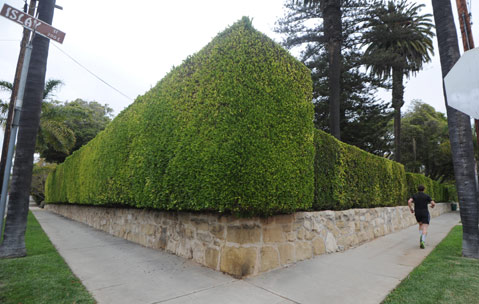Shrub Wars
City Considers New Rules of Engagement

While the rest of the globe explodes in waves of sectarian violence, Santa Barbarans are enjoying the relative luxury of arguing over shrub heights. However silly the issue appears, it’s proved sufficiently contentious that the Santa Barbara City Council felt compelled to declare a moratorium on shrub-height enforcement actions six years ago. That moratorium, which has been extended several times, expires next month. This Tuesday, the City Council’s ordinance committee inched toward passing a new measure to replace the ordinance that’s been in effect since 1957.
Except where traffic visibility and safety concerns dictate otherwise, the proposed changes would allow shrub heights to increase by as much as 100 percent in certain circumstances and would give city planning officials greater latitude in allowing exceptions. Public comment on the matter was intense, voluble, and sharply split. Likewise, the Ordinance Committee itself was divided, with Councilmembers Frank Hotchkiss and Cathy Murillo voting in favor of the changes, while Randy Rowse voted against them.
Hotchkiss pushed for some decidedly unorthodox language that would prevent City Hall staff from responding to shrub-height complaints from anyone not immediately affected. Likewise, he pushed for what he termed a “what’s good for the goose is good for the gander” clause, meaning that the complaining parties had to conform to the city’s shrub limits themselves. These proposals, however unusual, reflect the incident giving rise to City Hall’s meltdown over shrub-height enforcement in 2008. In that case, a Riviera resident — unhappy at what she contended was the arbitrary and unfair nature of City Hall’s shrub enforcement — filed more than 25 complaints against people in her neighborhood who she argued were at least as noncompliant as she’d been.
Then as now, city officials insist they take enforcement action only upon complaint. The existing ordinance allows front-yard shrubs to be no more than three-and-a-half feet in height and side yard shrubs to be no more than eight feet tall. The proposed new language to the city’s ordinance — governing not just hedges, but fences, outside walls, gates, and screens — would allow front- and side-yard shrub heights of seven-and-a-half feet and 12 feet, respectively. Supporters of the existing height limits argued that proposed changes would be unsafe. Because children “are not seven feet tall,” one woman testified, they would have a hard time seeing oncoming traffic over the new higher shrubs. She likewise complained that shrubs are breeding ground for rats and that they pose a fire hazard.
Others argued that residents need some legal protection when bad neighbors maliciously block their views and solar access by allowing their vegetation to sprout out of control. Jake Clinton of Nite Moves fame implored the council take action against “spite fences,” like the one he said his neighbor built in their shared driveway last year using cinder blocks, plastic toilet pipes, and a hodgepodge of other materials. Krista Pleiser of the Board of Realtors urged legislative restraint, arguing, “If people want to build a spite hedge, they’re going to build a spite hedge.”
And many showed up to argue in favor of greater latitude when it came to shrubbery. The greenery, they said, produced oxygen, protected privacy, blocked noise, and filtered air pollution. Several expressed serious doubt that high shrubs could be linked to a single traffic accident and charged the city’s ordinance constituted an assault on private property rights. (Traffic planner Derrick Bailey said 26 pedestrians had been struck by cars coming out of their mid-block driveways since 2000.)
Many speakers expressed concern about a wave of enforcement actions and the time and cost that will be required to secure the necessary variances. Hedge regulation, many Upper Eastside residents argued, should be included in other city ordinances regulating solar access or view dispute resolution. Many Upper Eastside homes, they said, would have a hard time complying with the new ordinance let alone the existing one. The solar-access ordinance would allow for even higher hedges than the new hedge ordinance would.
Only Councilmember Rowse supported that approach. Tuesday’s deliberations were the first of many for the City Council, coming on the heels of seven public hearings on the matter to date. As Acting Community Development Director Bettie Weiss said, “Hedges are difficult.”



